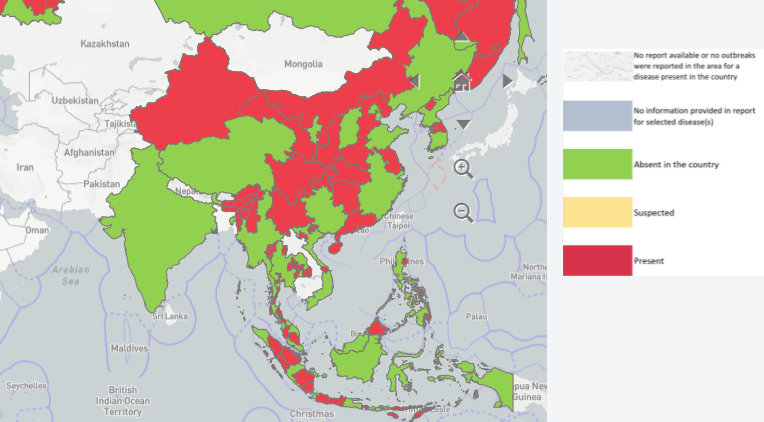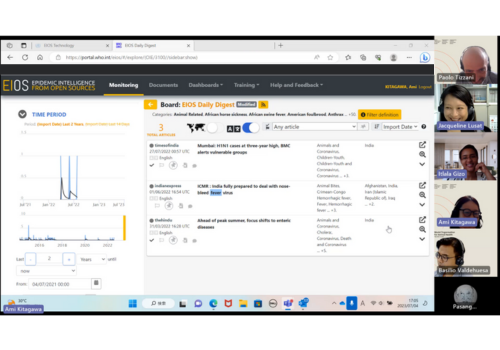
This project aims to enhance early detection of animal diseases in the Asia-Pacific region through transparent disease reporting. By fostering data sharing, refining data analysis, and strengthening communication, WOAH seeks to empower its Members and Partners to make informed decisions and respond effectively to disease outbreaks.
An Active Search Team for Asia-Pacific (AST Asia-Pacific) was established to monitor for early signs of disease threats. This team consists of technical and communication officers in the region who have been trained in the Epidemic Intelligence from Open Sources (EIOS) system (WHO EIOS initiative). By collecting information from various online sources and analysing it, the team identifies potential disease outbreaks and, if necessary, contacts relevant countries or territories to clarify important news signals. The team uses the EIOS portal for its daily work.
The AST Asia-Pacific collaborates closely with the WOAH active search team based within the World Animal Health Information and Analysis Department (WAHIAD) and receive support from epidemiologists at the Data Integration Department (DID), both based at the WOAH headquarters. AST Asia-Pacific conducts active search activities following the procedures established by WAHIAD (as outlined in the Active search for non-official animal health information). Information gathered from news signals is analysed to ensure it aligns with official disease information available in the World Animal Health Information System (WAHIS) (accessible here: WAHIS portal). While AST Asia-Pacific primarily focus on EIOS at current, it’s crucial to note that EIOS is not the sole tool WOAH use for epidemic intelligence work, particularly at headquarters. WAHIAD collaborates with the Global Early Warning and Response System (GLEWS) network for zoonotic diseases.
The project has made significant progress in its first year. Key achievements include:
is to strengthen early warning capabilities in the Asia-Pacific region through effective data management, analysis, and communication.
Building upon the strong foundation established in the first year, the project is ready for continued growth and impact. Key priorities for the coming months include:
By focusing on these areas, the project will contribute to a more resilient and secure animal health landscape in the Asia-Pacific region.
While the project has made significant strides, it is essential to acknowledge the challenges and capitalise on emerging opportunities.
Challenges:
• Data quality and consistency: Ensuring the accuracy and reliability of data from diverse sources remains a challenge.
• Resource constraints: While significant progress has been made, challenges related to data sensitivity remain. The team is working to address these issues while continuing to enhance the early warning system.
• Building capacity: Developing the necessary skills and knowledge within WOAH Members and Partners requires sustained effort.
Opportunities:
• Leveraging technology: Advancements in technology can enhance data collection, analysis, and dissemination.
• Strengthening partnerships: Collaborating with other organisations can expand the project’s reach and impact.
• Knowledge sharing: Sharing best practices and lessons learned can accelerate progress across the region.
By proactively addressing challenges and seizing opportunities, the project can continue to make a meaningful contribution to animal health security in the Asia-Pacific region.
To support the project’s goals and contribute to a safer and more secure animal health environment in the Asia-Pacific region, we encourage:
• WOAH Members: Active participation in data sharing, capacity building activities, and knowledge exchange.
• Non-member countries: Engaging with WOAH to access project resources and benefits.
• Partners and stakeholders: Collaborating on joint initiatives and leveraging complementary expertise.
By working together, we can strengthen early threat warning systems and protect animal health for the benefit of all.
The ultimate aim is to strengthen early warning capabilities in the Asia-Pacific region through effective data management, analysis, and communication.
(Virtual) WOAH EIOS training, October 2023
For more information about the project or to get involved, please contact:
Jacqueline Lusat
Animal Health Information Officer
WOAH Regional Representation for Asia and the Pacific
Tokyo, Japan.
[email protected] | +81 (0) 3 5805 1931 | WOAH Regional Representation for Asia and the Pacific
Paolo Tizzani
Senior Veterinary Epidemiologist
Data Integration Department, WOAH Headquarters
Paris, France
[email protected] | +33 (0) 1 4415 1923 | WOAH
We look forward to collaborating with you to strengthen early threat warning in Asia and the Pacific.




